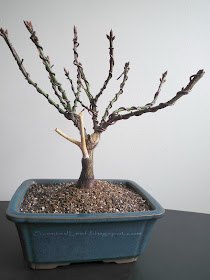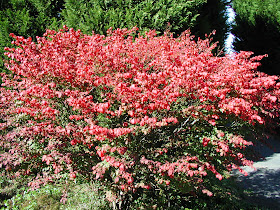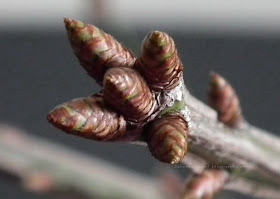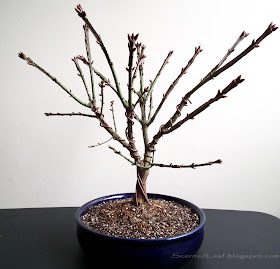Yeah, I know, they are still without leaves, and perhaps they are under- appreciated if you don't know much about the Euonymus genus (translated as "good name").
 |
| Euonymus Alatus bonsai - broom style |
Euonymus
is a deciduous shrub from Celastraceae family native to Asia, and the Alatus Species is known also as Burning Bush or Winged Euonymus - as reference to their winged branches with longitudinal cork cambium. The leaves are growing with a dark green color in summer which is changing in autumn in an attractive bright red(burning bush) if is kept in sunny places or faded red if is kept in shady sites.
 |
| Burning Bush foliage in autumn - Picture courtesy of Wikimedia Commons |

 |
| Burning Bush / Euonymus Alatus brownish-green buds |
The classical
Euonymus Alatus is a large-sized spreading shrub overused in landscaping, but it became a nice bonsai if you are searching for smaller cultivars, especially "Compacta". Their leaves with serrated margins will start soon to grow from the brownish green buds, covering with a dense canopy their slightly fissured trunk and the corky stems with green and brown areas. I'm still waiting to loom into their canopy of leaves some greenish blooming in spring and red berries in autumn...
 |
| Burning bush trunk and corked branches |
 |
| Euonymus Alatus bonsai in round pot |
This bonsai takes well to pruning and wiring and because have a rounded multi-stemmed branching habit, we wired them in an informal and broom styles. They were trained in 1 gallon pots last year (I'm sorry but I did not find their pictures I've taken in last autumn). We trimmed the root ball and transplanted them easily in bonsai pots because they have a lot of finer, feeder roots (if left un-pruned tend to become pot-bound). They are tolerant of many conditions (soils, watering or sun exposure) and usually have no serious pests problems. Yearly, it is a very decorative plant for almost 9 months - so we must not be upset for their resting winter stage.










Muy buen post. Tengo varios bonsai en mi jardin.
ReplyDeleteSaludos,
Simple Torsion
ugg uk
ReplyDeletechristian louboutin pas cher
pandora charms
burberry handbags
ugg outlet
cheap oakley sunglasses
uggs outlet
ugg boots
burberry handbags
cheap uggs
2016.10.12xukaimin
As much as your thinking is praised, it is very important to have a beautiful thinking to write a beautiful post and indeed such a beautiful post is rarely seen as much as the beautiful post you have written, it is a very beautiful of my life The post is what I saw today.
ReplyDeleteEscorts service in Calangute Beach
Escorts Service in Palolem Beach
gurgaon call girls
neemrana call girls
call girls in gurugram
call girls in gurugram
Gurugram escorts
hot call girls in gurugram
VIP Girls
escort service gurugram